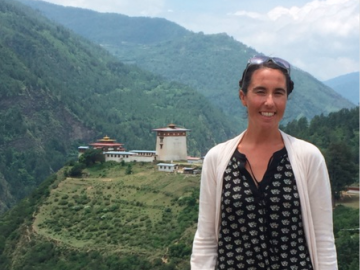
The University of Arizona Parent & Family Association's monthly faculty spotlight for December is on Rae Erin Dachille, an assistant professor of Religious Studies and East Asian Studies and an expert on Buddhism.
Here's the full profile:
Meet Rae Erin Dachille: Professor Who Brings Buddhist Studies to Life
As an undergraduate at Sarah Lawrence College, Dachille says a class trip to New York’s Asia Society to see an exhibition of Tibetan art and monks creating a sand mandala became a captivating moment that turned her toward Buddhist Studies and the rituals of art.
As a new assistant professor of Religious Studies and East Asian Studies, Dachille took a group of 10 students to Bhutan last summer on the University of Arizona’s first study abroad program to the Himalayan country, focusing on spiritual ecology and independent, mentored student research as they experienced Buddhist temples, monasteries, and pilgrimage sites.
“I’ve been told that only the person who asks a question can truly understand its answer,” Dachille says. “Engaged learning opportunities like study abroad and the sand mandala provide students access to the kind of direct experience of religious traditions that spark exciting and meaningful questions for them. The shared nature of this experience is key to its success. The mentored research component of Arizona in Bhutan focuses precisely on supporting students in refining their questions about Buddhist cultures through dialogue with mentors and peers.”
Dachille will lead a return study abroad trip to Bhutan in summer 2019 and encourages students regardless of major to explore the program, with university scholarships available as well as scholarships provided specifically for Religious Studies majors.
The study of world religions, Dachille says, encourages students’ curiosity about different ways of understanding how humans situate themselves in the world and in relationship to communities.
“This curiosity is essential for students to appreciate the incredible spectrum of ways of seeing the world around them and the possibilities for collaboration across boundaries beyond the walls of the classroom,” she says.
The study of religion reveals broader insights into various traditions and cultures, and in that way, Dachille finds common ground with scholars of fields like anthropology, science, and especially art, reflecting her own exploration of relics that span traditions from Christianity to Hinduism and Buddhism.
“I am drawn to the study of religion as a way of understanding how human individuals and communities make meaning, how they construct their worlds and make their lives meaningful,” she says. “Studying the relationship of art and religion across traditions has challenged and enriched my definition of what ‘art’ is.”
After graduating from Sarah Lawrence College, Dachille earned an M.A. in Asian art history and an M.A. in languages and cultures of Asia from the University of Wisconsin-Madison. Dachille received her Ph.D. in Buddhist Studies from the University of California at Berkeley, specializing in the religious and artistic traditions of Himalayan Buddhism. She was the Department of Religious Studies’ Burns Faculty Fellow 2016-2017. In spring 2018, Dachille is teaching a general education course in Tibetan Buddhism as well as a seminar on Tantric Buddhism oriented around the question “What is ritual?” In the coming year, she looks forward to teaching a new course on Buddhism and Healing.
Last spring, Dachille organized a campus visit by a group of Tibetan Buddhist monks, who spent five days in the bookstore creating a sand mandala, after which they washed it away to represent the impermanence of life. Observing the ritual gave students a real-life illustration of the traditions they study in the classroom and readings, with a captivating immediacy.
“Some experiences stop us dead in our tracks and demand our full attention in the moment. The study of Buddhist provides many such moments, and I work to help students access as many of them as possible, both within the classroom and beyond,” Dachille says.

